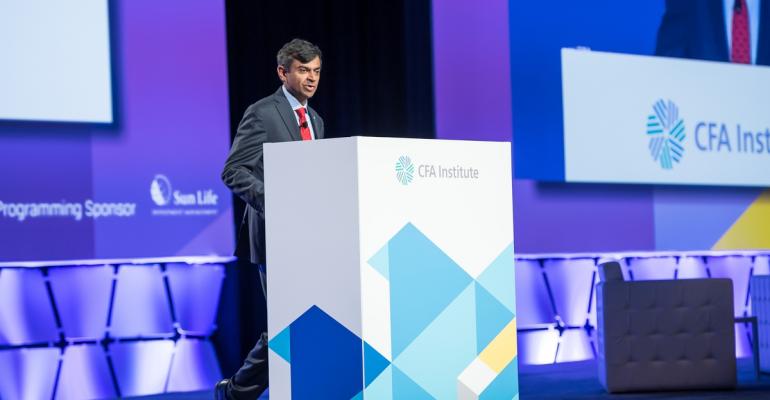Many advisors are still rooted in asset allocation and risk-adjusted returns. But asset allocation is no longer the real value proposition; the real value is in understanding the client’s goals and then creating a framework to execute on those goals through volatile markets. That’s what Ashvin Chhabra, President of Euclidean Capital, argues in his book The Aspirational Investor: Taming the Markets to Achieve Your Life’s Goals, released last summer. In a recent interview with WealthManagement.com, Chhabra says investors need a safety portfolio, a market portfolio and an aspirational portfolio.
WealthManagement.com: What are people doing wrong when it comes to investing?
Ashvin Chhabra: A lot of the investment advice roots from 1950s, from Harry Markowitz—diversification. But then the minute the first interesting company comes along, everybody jumps in and says, ‘This is the next Google.’ So people tend to be very interested in lottery tickets.
So when markets are going up, this behavior becomes much worse, and so you get these bubbles and people just lose a lot of wealth in these bubbles. At the same time when the world is crashing, people become incredibly risk-averse.
Think about how a price is set. When somebody buys and somebody sells in the market, people agree on the price, but they’re disagreeing on future expectations. So the market is actually built on fundamental disagreements of future expectations. So when you’re investing over a lifetime, you should expect bubbles and crashes; that’s the norm just from the structure.
But when you talk about essential goals, you have to find a way to create safety, to make sure your goals are achieved regardless of the markets. That was the fundamental idea—that we do investing all wrong. We think about markets, we think about returns, we talk about benchmarks, we talk about risk-adjusted returns, and we define success in investment management as beating a benchmark. If you didn’t achieve your goal, it doesn’t matter whether you beat the benchmark.
WM.com: How did you come up with the investing framework outlined in the book?
AC: I thought, let me go deep and understand firstly, how do you achieve safety? And the answer is not from a market portfolio because if you hold the market portfolio, when the market crashes, your portfolio will crash.
I also asked the flip side of the question, how is wealth created? I went back and studied the Forbes 400 and said, ‘How do people get really wealthy?’ It turns out that wealth gets created through leverage; you need non-recourse leverage. Non-recourse leverage means that when things go wrong, it doesn’t impact your entire life and your entire portfolio, but only that piece. You also need to concentrate. That only works if you have a certain skill. Otherwise, that concentration and leverage will create a lot of volatility and you’ll get wiped out. So it’s the amplification of human alpha, or human capital. Human capital turns out to play a very important role in almost every aspect—first in understanding what your goals are and secondly in achieving them. The idea was, investing is not about the markets; investing is about you.
WM.com: What is the framework that people should be using when they invest?
AC: Everybody needs a safety portfolio. You should have a market portfolio because it’s too expensive to have a safety portfolio. And then you may have an aspirational portfolio. But you should only have an aspirational portfolio if you have a certain skill set. Your education could be your aspirational portfolio. It doesn’t have to be an investment. Specializing, being really good at what you do, your passion—that could be part of your aspirational portfolio.
So it becomes really important to figure out how to take your entire balance sheet and examine it in this framework—called the “wealth allocation framework.” The safety bucket will give you zero return, because it’s like buying insurance. The market portfolio will give you market return, but you don’t know what it is and you don’t know how volatile it’s going to be. And the aspirational portfolio is by nature risky, but done right, it could create great wealth.
WM.com: What should advisors be doing to apply this?
AC: Many advisors have started adopting the framework, but many of them are still rooted in asset allocation. I think the most important role of the financial advisor is helping the client navigate bubbles and crashes, and they’ll add much more value there than trying to pick the next manager that beats the benchmark. The probability of being able to predict those managers—it’s a very tough game.
The secret to the market portfolio is being contrarian and over time adding when the market crashes. You can’t do that psychologically unless you have the safety portfolio. Similarly when the market is rising and people want to go up the risk spectrum, you remind them that’s the aspirational portfolio and you should only do it if you have a certain human alpha—that is, you have an edge in a certain area.
In order to get real adoption, the industry will have to step up because a lot of the investment products that are made in the investment management industry today are designed around the Markowitz framework. Mutual funds, ETFs—they’re really around benchmarks and risk-adjusted benchmarks.





